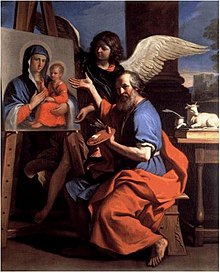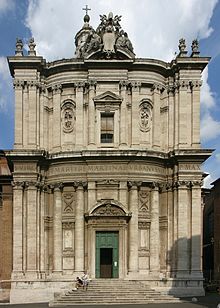Accademia di San Luca
 St. Luke Displaying a Painting of the Virgin by Guercino | |
| Named after | St. Luke |
|---|---|
| Formation | 1577 |
| Founded at | Rome |
| Type | Association of artists |
| Coordinates | 41°54′6″N 12°29′1″E / 41.90167°N 12.48361°E |
| Leader | Federico Zuccari |
| Secessions | Accademia Nazionale di San Luca |
| Website | accademiasanluca |
Formerly called | Compagnia di San Luca |
The Accademia di San Luca (English: Academy of Saint Luke) is an Italian
From the late sixteenth century until it moved to its present location at the Palazzo Carpegna, it was based in an urban block by the Roman Forum and although these buildings no longer survive, the Academy church of Santi Luca e Martina, does. Designed by the Baroque architect, Pietro da Cortona, its main façade overlooks the Forum.
History
The Academy's predecessor was the Compagnia di San Luca, a guild of painters and miniaturists, which met in the demolished church of S.Luca all'Esquilino, near the Basilica of S. Mary Major,[3] and whose statutes and privileges were renewed 17 December 1478 by Pope Sixtus IV. Among the founding members was the famous painter Melozzo da Forlì, as he was the pictor papalis.

Through the initiative of Girolamo Muziano, who was both one of the leading artists in Rome and superintendent of works for Pope Gregory XIII, the Pope granted the Academy official recognition in 1577. In 1588 Pope Sixtus V gave the institution the ancient church of S. Martina, which was rededicated as Santi Luca e Martina.[4]
In 1605, Pope
At some after 1634, during the time when Pietro da Cortona was principe, the accademia began to admit architects, who enjoyed the same status as painters and sculptors.[2] The Academy offered courses in painting, sculpture and architecture. Competitions open to artists and architects of all nationalities under 25 years old, the Concorsi Clementini, were held annually until 1721, when they became triennial. In 1763 these were supplemented by the Concorsi Balestra, and thereafter the two competitions alternated biennially.[9]
In 1845, the Academy expanded to the Palazzo Camerale on the Via di Ripetta in order to have the art students in one location. This later became the Liceo Artistico Ripetta.[10]
The Cortona-Sacchi Debate and other artistic issues
Artistic issues debated within the Academy included the Cortona-Sacchi controversy (see Andrea Sacchi for further details of this debate) about the number of figures in a painting. Disdain was expressed by many academicians for the Bamboccianti.[11]
Recent times

Due to the construction of
The Academy is still active; the Accademia Nazionale di San Luca is its modern descendant. From the very beginning, the statutes of the Academy directed that each candidate-academician was to donate a work of his art in perpetual memory and, later, a portrait. Thus the Academy, in its current premises in the 16th-century Palazzo Carpegna, located in the Piazza dell'Accademia di San Luca, has accumulated a unique collection of paintings and sculptures, including about 500 portraits, as well as an outstanding collection of drawings.[2] The Academy also hosts exhibitions of the works of various artists.[12]
The Library of the National Academy of San Luca houses the Academic Library and the Sarti Roman Municipal Library, which together hold over 50,000 volumes regarding ipainting, sculpture and architecture.[5] Scholarships are periodically announced for research activities in academic archives or abroad.[2]
Notable people
Faculty
- Pietro Angeletti, painter in a Neoclassical style
Principi
Prominent artists to become Principe of the academy over the first 200 years include:
- Federico Zuccari, 1593
- Tommaso Laureti, 1595
- Giovanni De Vecchi, 1596
- Cesare Nebbia, 1597
- Durante Alberti, 1598
- Flaminio Vacca, 1599
- Cavalier d'Arpino, 1600, 1616, 1629
- Girolamo Massei, 1603
- Pietro Bernini, 1605, 1606
- Paolo Guidotti, 1607, 1620
- Gaspare Celio, 1609
- Cherubino Alberti, 1611–1613
- Ottavio Leoni, 1614–1615, 1627
- Giovanni Baglione, 1617–1619
- Gian Lorenzo Bernini, 1621, 1630
- Agostino Ciampelli, 1623
- Antiveduto Gramatica, 1624
- Virginia Vezzi, 1624
- Simon Vouet, 1624–1627
- Baldassare Croce, 1628
- Domenichino, 1629
- Giovanni Lanfranco, 1631, 1632
- Francesco Mochi, 1633
- Pietro da Cortona, 1634–1636
- Alessandro Turchi, 1637, 1638
- Giovanni Francesco Romanelli, 1639
- Alessandro Algardi, 1640
- Girolamo Rainaldi, 1641–1643
- Niccolò Menghini, 1645–1647
- Giovanni Battista Soria, 1648–1650
- Luigi Gentile da Bruxelles, 1651–1653
- Pietro Martire Neri, 1654
- Bernardino Gagliardi, 1655–1658
- Nicolas Poussin, 1657 (resigned)
- Raffaello Vanni, 1658–1660
- Gaspare Morone, 1661
- Pier Francesco Mola, 1662, 1663
- Carlo Maratta, 1664–1665, 1699, 1706–1713
- Giovanni Francesco Grimaldi 1666
- Melchiorre Cafà, 1667 (declined)
- Orfeo Boselli, 1667
- Pietro del Pò
- Giacinto Brandi 1669, 1684
- Domenico Guidi, 1670, 1675
- Giovanni Maria Morandi, 1671, 1680, 1685
- Charles Errard, 1672, 1678
- Carlo Rainaldi, 1673
- Giovan Battista Gaulli, 1674
- Carlo Cesi, 1675
- Charles Le Brun, 1676–1677
- Lazzaro Baldi, 1679
- Mattia de Rossi, 1681, 1693
- Luigi Garzi, 1682
- Giovanni Battista Contini, 1683, 1719
- Filippo Lauri, 1686 (resigned)
- Carlo Fontana, 1686, 1694
- Ludovico Gimignani 1688
- Giovan Battista Boncori, 1698
- Charles-François Poerson, 1714, 1718
- Benedetto Luti, 1720
- Giuseppe Bartolomeo Chiari, 1723–1725
- Antonio Valeri, 1726
- Camillo Rusconi, 1727, 1728
- Sebastiano Conca, 1729, 1739
- Girolamo Teodoldi, 1734, 1742
- Agostino Masucci, 1736–1738
- Gaetano Lapis, 1741
- Jean-François de Troy, 1744
- Giovanni Battista Maini, 1746, 1747
- Tommaso de Marchis, 1748
- Francesco Mancini, 1750–1751
- Filippo della Valle, 1752, 1760–1761
- Ferdinando Fuga, 1753–1754
- Giovanni Paolo Pannini, 1755
- Pietro Bracci, 1756
- Clemente Orlandi, 1757
- Placido Costanzi, 1758
- Mauro Fontana, 1762
- Francisco Preciado de la Vega, 1764–1766, 1777–1778
- Andrea Bergondi, 1767, 1779–1780
- Anton Raphael Mengs, 1771–1772
- Carlo Marchionni, 1773
- Ferdinando Raggi, 1781
- Anton von Maron, 1784
- Agostino Penna, 1787–1789
- Antonio Asprucci, 1790
- Tommaso Conca, 1793
- Vincenzo Pacetti, 1796, 1800, 1801
- Andrea Vici, 1802
- Vincenzo Camuccini, 1806–1810
- Antonio Canova, 1811 (permanent principe 1814 to 1822)
- Gaspare Landi, 1817–1820
- Alessandro Massimiliano Laboureur, 1820–1822
- Girolamo Scaccia, 1823
- Vincenzo Camuccini, 1826
- Bertel Thorvaldsen, 1827–1828
- Giulio Camporese, 1829
- Andrea Pozzi, 1830–1831
- Antonio D'Este, 1832
- Tommaso Minardi, 1837
- Clemente Folchi, 1841–1843
- Luigi Poletti, 1849–1853
- Filippo Agricola, 1854–1855
- Virginio Vespignani, 1870, 1876–1877
- Nicola Consoni, 1878, 1883
- Stefano Galletti, 1899, 1900
Claude Lorrain was a member but declined the offer of being Principe. The Academy can also boast modern members, including sculptors Ernesto Biondi and Piccirilli Brothers.[citation needed]
References
- ISBN 0-521-55988-X.
- ^ a b c d e "Origini dell'Accademia". accademiasanluca.it (in Italian). Retrieved 18 January 2023.
- ^ a b "Accademia di S.Luca", Roma Segreta
- ^ Jorg Martin Merz, Pietro da Cortona and Roman Baroque Architecture, 2008, Yale University Press, p. 53
- ^ a b "National Academy of San Luca Library", Turismo Roma, Major Events, Sport, Tourism and Fashion Department
- ^ ISBN 978-0-300-02540-8.
- ^ "ASR, TNC, uff. 15, 1627, pt. 2, vol. 112, fols. 323r-v". The History of the Accademia di San Luca: Documents from the Archivio di Stato di Roma, c. 1590–1635. The Center for Advanced Study in the Visual Arts, National Gallery of Art, Washington, DC. Retrieved 14 February 2022.
- ^ " Accademia di San Luca", The Royal Collection Trust
- National Galleries of Scotland, Edinburgh, p. 28
- ^ "Liceo artistico statale "Via di Ripetta": la storia".
- JSTOR 3050166.
- ^ "Rome, Accademia di San Luca celebrates Guido Strazza: an exhibition for the artist's 100th birthday", Finestre sull'Arte, June 21, 2023
